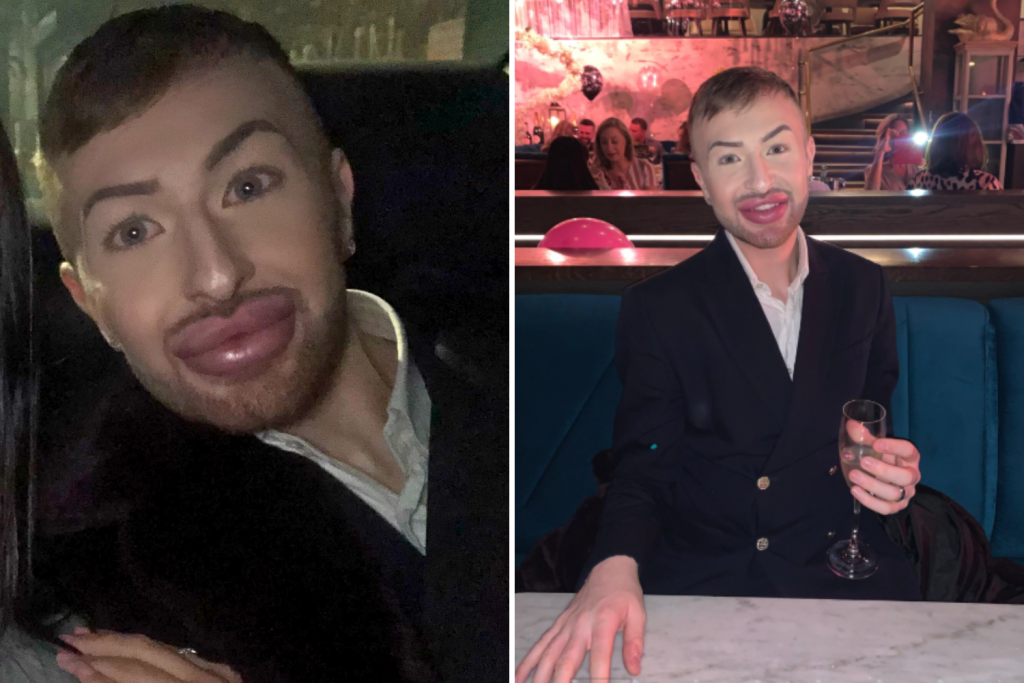The Journey Through Facial Fillers: Christopher Sharratt’s Story of Addiction and Recovery
In a candid revelation about the hidden dangers of cosmetic procedures, 25-year-old Christopher Sharratt from Staffordshire, England has shared his profound journey with facial fillers – from addiction to recovery. His story begins at just 17, when he lied about his age to receive his first injections, setting off a years-long cycle that would cost him approximately £3,500 ($4,400) – “half a house deposit,” as he ruefully notes. The before-and-after photos tell a stark tale: once sporting dramatically enlarged lips and facial swelling, Sharratt has now returned to a natural appearance after undergoing four painful rounds of filler dissolving treatments. His experience reveals the psychological complexities behind cosmetic procedures and highlights the dangerous lack of regulation in an industry that can permanently alter people’s appearances and self-perception.
What makes fillers particularly insidious, Sharratt explains, is the temporary swelling that follows injections, creating a deceptive cycle of satisfaction and disappointment. “You have a mil [millimeter] and your lips swell up or wherever you have it on your face. And you’re like, oh my God, this swelling looks so good. And a week later, the swelling goes down and you’re like, oh c***, I need to go and get another mil,” he shared with Newsweek. This psychological mechanism is what Dr. Cali Estes, a psychologist and addiction specialist, refers to as a non-chemical but very real addiction. “Each injection gives an instant confidence boost, and the brain starts chasing that dopamine hit again—just like checking likes on social media,” she explains. Perhaps more concerning is what Dr. Estes calls “aesthetic blindness” – a phenomenon where people lose perspective on their changing appearance as their brain recalibrates to each new normal, leading them to continuously seek more dramatic results without recognizing how far they’ve strayed from their natural look.
The COVID-19 lockdown became Sharratt’s unexpected turning point. Unable to access treatments, he found himself looking at old photos and experiencing a moment of clarity: “I actually didn’t look that bad. I should have been a bit nicer to myself,” he reflected. This realization led to his decision to reverse the procedures, but the journey back wasn’t simple. The dissolution process was both painful and complicated due to the extensive amount of filler in his system. “I had four rounds of dissolver because I had so much filler in my lip. Cheeks and jaw were easy to get rid of, but I actually had to start pulling my lips out and putting it in the back because there was nowhere else to fill out,” Sharratt described. His experience shatters the common misconception that fillers simply dissolve over time – in reality, they can migrate throughout the face and cause long-term structural changes that patients are rarely warned about before treatment.
Sharratt’s story brings into sharp focus the alarming lack of regulation in the British cosmetic industry, where fillers are often administered in beauty salons without proper medical oversight. “There needs to be so much more regulation in place,” he insists. “No 17-year-old should be going to get fillers. Nobody.” This contrasts with the United States, where dermal fillers are regulated by the FDA and generally limited to administration by licensed medical professionals. Even with these regulations, state-by-state variations and differing age requirements still leave room for potential issues. The most troubling aspect, according to Sharratt, is the lack of informed consent about long-term risks. “Nobody tells you the fact that it doesn’t dissolve… It doesn’t, it moves around your face,” he warns, adding that overstretched tissue can remain permanently altered – crucial information that patients deserve to know before making decisions about cosmetic procedures.
The psychological dimensions of cosmetic procedures cannot be overstated, as Dr. Estes emphasizes: “Fillers are often treated like beauty services, but they carry medical risks—including blindness. For those with body dysmorphia or addictive patterns, the lack of safeguards is dangerous.” This highlights the need for more than just physical health screenings but psychological evaluations as well, particularly for younger patients or those seeking repeated treatments. The current approach, which often treats fillers as simply another beauty service rather than a medical procedure with significant risks, creates a perfect environment for addiction and self-image distortion. Stronger psychological screening and ethical limits would protect vulnerable individuals not just from physical complications but from the psychological harm that can result from chasing increasingly dramatic changes to one’s appearance.
Now embracing his natural look, Sharratt reports feeling more approachable and confident in daily life. “More people come up to me now than ever. People wouldn’t come up and say hello,” he shared, suggesting that his extreme fillers may have actually created a social barrier rather than enhancing his interactions. His willingness to publicly acknowledge his regrets represents a courageous step in an industry where few discuss the downside of cosmetic procedures. “Hopefully I can be one of the few people to put their hand up, say I’ve made a mistake, we need to do something about this,” Sharratt states. His story serves as both a personal redemption narrative and a powerful call for industry reform, reminding us that beneath the glossy promises of cosmetic enhancements lie real risks that deserve serious consideration. As society continues to navigate the complex relationship between appearance, self-worth, and medical intervention, voices like Sharratt’s provide essential perspective on the true costs of chasing artificial beauty standards.














